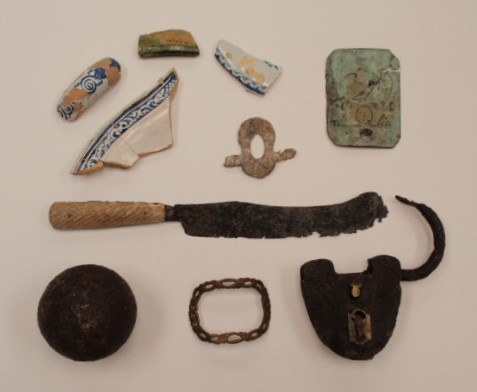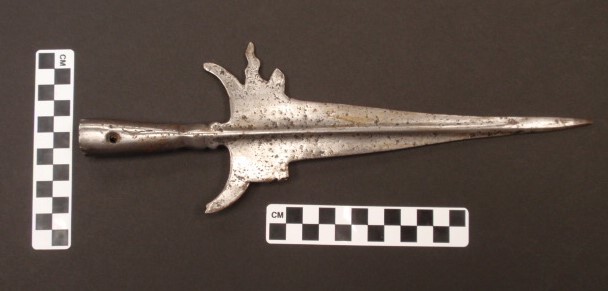History and collections
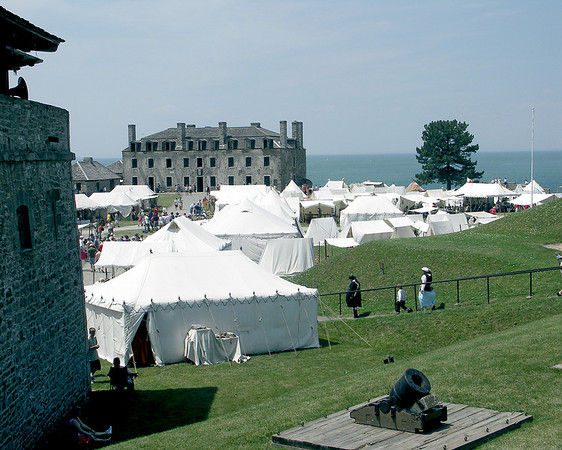
The history of Old Fort Niagara spans more than 300 years. During the colonial wars in North America, a fort at the mouth of the Niagara River was vital, for it controlled access to the Great Lakes and the westward route to the heartland of the continent. With the completion of the Erie Canal in 1825, however, the strategic value of Fort Niagara diminished. It nonetheless remained an active military post well into the 20th century.
The three flags flown daily above the parade ground symbolize the nations which have held Fort Niagara. Each competed for the support of a fouth nation: the powerful Six Nations Confederacy. The French established the first post here, Fort Conti, in 1679. Its successor, Fort Denonville (1687-88) was equally short lived. In 1726 France finally erected a permanent fortification with the construction of the impressive "French Castle." Britain gained control of Fort Niagara in 1759, during the French & Indian War, after a nineteen-day seige. The British held the post throughout the American Revolution but were forced, by treaty, to yield it to the United States in 1796. Fort Niagara was recaptured by the British in 1813. It was ceded to the United States a second time in 1815 at the end of the War of 1812.
This was Fort Niagara's last armed conflict, and it thereafter served as a peaceful border post. The garrison expanded beyond the walls following the Civil War. Fort Niagara was a barracks and training station for American soldiers throughout both World Wars. The last army units were withdrawn in 1963. Today, the U.S. Coast Guard represents the only military presence on the site.
Old Fort Niagara was restored between 1929 and 1934. It is operated today by the Old Fort Niagara Association, Inc., a not-for-profit organization, in cooperation with the New York State Office of Parks, Recreation and Historic Preservation. Admission fees, Museum Shop sales, grants, and donations provide support for the operation of the site. Membership in the Old Fort Niagara Association is open to all.
Historical Timeline
17th Century- Senecas occupy a seasonal hunting and fishing camp at the future site of Fort Niagara
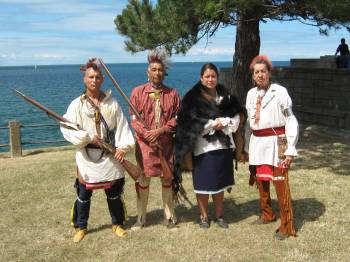 1669- First documented visit of a European to the future site of Fort Niagara
1669- First documented visit of a European to the future site of Fort Niagara
1679- French erect Fort Conti. The post burned down before the end of the year.
1687- French erect Fort Denonville as part of their campaign against the Seneca. Of 100 men left to winter at the fort, only 12 survived.
1720- Louis-Thomas Chabert de Joncaire erects Le Magazin Royal at the present site of Artpark in Lewiston.
1726-27 French erect the French Castle.
1744-48 King George’s War. The French strengthen Fort Niagara and construct a Bake House in 1747.
1749- Celoron’s Expedition, to formally claim the Ohio Valley, passes through Fort Niagara.
1754-1763- French and Indian War. The French strengthen Fort Niagara. Massive earthen walls are constructed and additional buildings erected.
1757- The French erect a large stone Powder Magazine
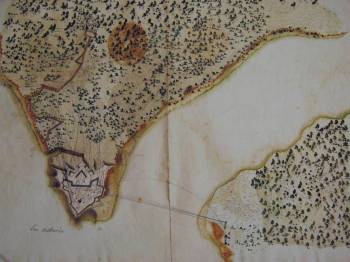
1759- After a 19-day siege, Fort Niagara falls to the British.
1762- British rebuild the Bake House and Provisions Storehouse
1763-66 Native American Uprising known as Pontiac’s War. Fort Niagara plays a key role in supplying Detroit. In September, British forces are defeated at Devil’s Hole, 11 miles south of Fort Niagara.
1764 British forces under Colonel John Bradstreet camp at the fort on their way to relieve Detroit. Sir William Johnson holds the largest Native peace conference to date at the fort.
1770 & 1771 - The British build two Stone Redoubts to shore up eroding defenses.
1775-1783 – American War of Independence. British forces hold Fort Niagara and use it as a base for frontier raids and as a refuge for Loyalists and Native American allies.
1796- Fort Niagara is turned over to the United States.
1812- Fort Niagara and British Fort George trade artillery bombardments. The fort’s heroine, Betsy Doyle, carries hot shot to a gun on the roof of the French Castle.
1813- Fort Niagara supports the American capture of Fort George. In December, Fort Niagara is captured by British forces.
1815- U.S. troops reoccupy Fort Niagara
1825- The opening of the Erie Canal diminishes Fort Niagara’s strategic importance.
1839-1843- In response to the Canadian Rebellion of 1837, the U.S. makes extensive alterations to buildings and fortifications at Fort Niagara. A new stone wall and hot shot battery are constructed on the river side of the fort.
1863-72- In response to the Civil War (1861-65) Brick revetments are constructed along the fort’s walls.
1872- The Army garrison moves outside the old fort walls to New Fort Niagara.
1885- 1000-yard rifle range created.
1899- U.S. Troops train for service in the Philippines.
1917- Fort Niagara hosts two Officer Training Camps for service in World War One.
1927- The Old Fort Niagara Association is founded to save the old fort from ruin.
1934- Old Fort Niagara opens as a public museum
1941- Fort Niagara becomes an induction center for troops serving in World War Two.
1944-45 Fort Niagara serves as a prisoner of war camp for German and Austrian POWs
1952- With the advent of the Cold War, Anti-aircraft troops are stationed at the fort.
1963- Fort Niagara decommissioned as an active military post.
1985- Old Fort Niagara’s Collections Center established
2006- Visitor Center opens
Today- The fort welcomes over 200,000 visitors a year.
Collections
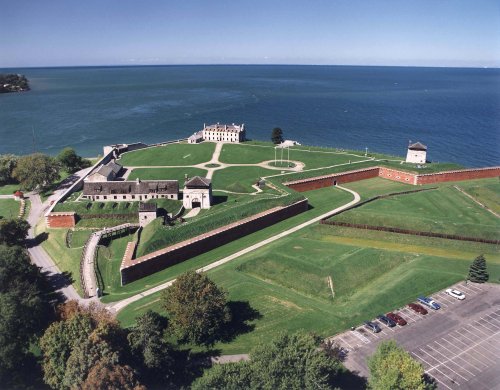
Old Fort Niagara features one of the nation’s finest collections of original 18th- and early 19th century military architecture and related artifacts. Museum collections span the years of pre-contact through the present. Collections include a comprehensive array of structures, artifacts and documentary materials depicting people and events throughout the site’s history.
The architectural collection includes six 18th century buildings, the oldest extant structures of any type in the Great Lakes region. The earliest, known as the French Castle, was built in 1726 and is the oldest building in North America situated between the Appalachian Mountains and the Mississippi River. Other 18th century buildings include an above-ground powder magazine (1757), Bake House (1762), Provisions Storehouse (1762) and two stone redoubts (1770 and 1771).
Five other buildings relate to the 19th and 20th century military post. The fort also has three extensive areas of 18th and 19th century fortifications, which provide examples of changing defensive technologies spanning a century of intense military activity in North America. These include earthen and log outer walls and fortified works originally constructed in 1755, stone walls and artillery emplacements from the first half of the 19th century and brick underground casemate galleries and outer walls dating from the 1863-72 period.
The archeological collection (103,000 specimens) is composed entirely of objects excavated at Fort Niagara or related sites and includes a small quantity of pre-historic material, large numbers of historic artifacts from 1679 to present and floral and faunal material. Because building locations throughout the history of the site are well documented and because the ground has been relatively undisturbed, artifacts can be identified in both temporal and physical contexts.
The general collection (2,051 artifacts) also spans the history of the site. These objects have been acquired by the Fort since 1931. While most are military in nature, special effort has been directed toward collecting objects representing the broader social and commercial impact of the site, its important role in European/Native relations and garrison/community interaction.
The collection includes 73 pieces of artillery, 115 small arms and edged weapons, 155 pieces of military clothing, 65 accouterments, 75 pieces of furniture, military insignia and ephemera relating to the garrison and to the Old Fort Niagara Association. The most significant single object in the general collection is the U.S. garrison flag from the War of 1812. This huge flag (24’ x 28’) is not only specific to the site, but it has national significance as one of only about 20 extant U.S. flags dating before 1815. Its manufacture predates its more famous sister, the Star Spangled Banner.
The library and archival collection is made up of 8,000 images of Fort Niagara; 3,000 books and periodicals, 3,500 manuscript items and a great quantity of reproduced primary source material gathered from other institutions.
Hours of Operation
January 13 through March, Open Wednesday-Sunday 10:00 a.m. to 4:00 p.m
April 1- June 30, Open Daily 10:00 a.m. to 4:00 p.m.
July and August, Open Daily 10:00 a.m. to 5:00 p.m.
September 1 - October 15, Open Daily 10:00 a.m. to 4:00 p.m.
October 16 - December 31, Open Wednesday through Sunday (Closed Mondays and Tuesdays) 10:00 a.m. to 4:00 p.m.
The fort will be open daily during Christmas week, December 26 - 31.
Closed New Year's Day, Thanksgiving Day and Christmas Day.
General Admission
|
Adults: |
$20.00 |
|
Children (6 to 12 years) |
$12.00 |
|
Children (5 and under): |
FREE |
Support the Fort
Old Fort Niagara is operated by the Old Fort Niagara Association, an independent, not-for-profit organization established in 1927. We do not rely on tax dollars. Instead, the Fort is funded through a combination of admission fees, museum shop sales, and charitable contributions.
.jpg)
Newsletter Sign-Up
Keep up to date on Old Fort Niagara events and happenings! Sign up here for our e-newsletter.

